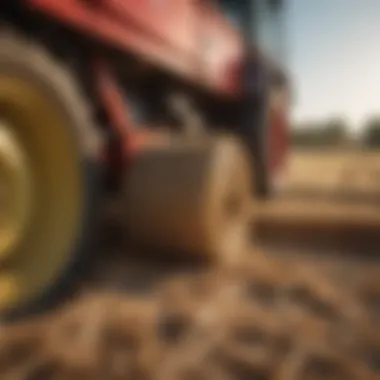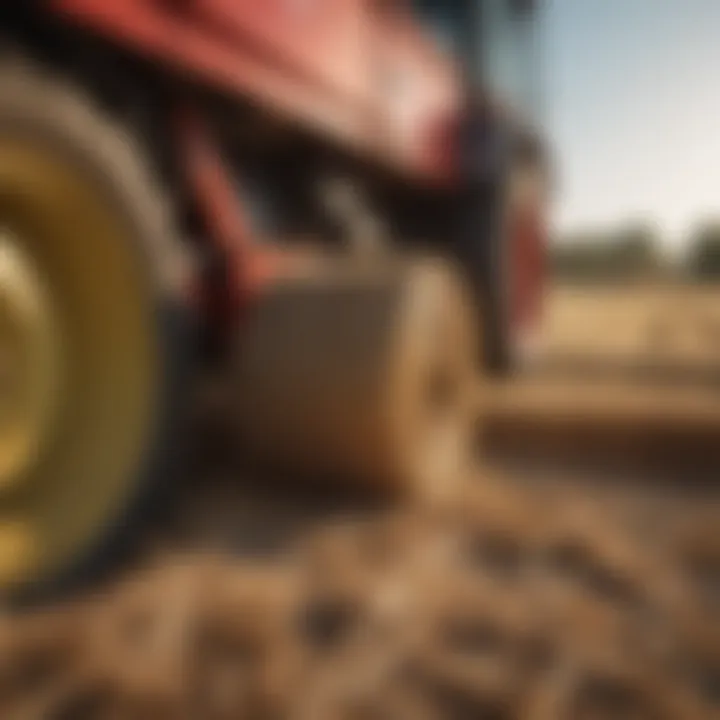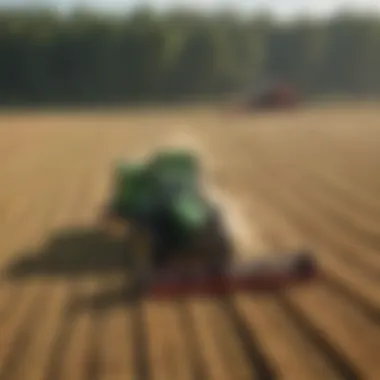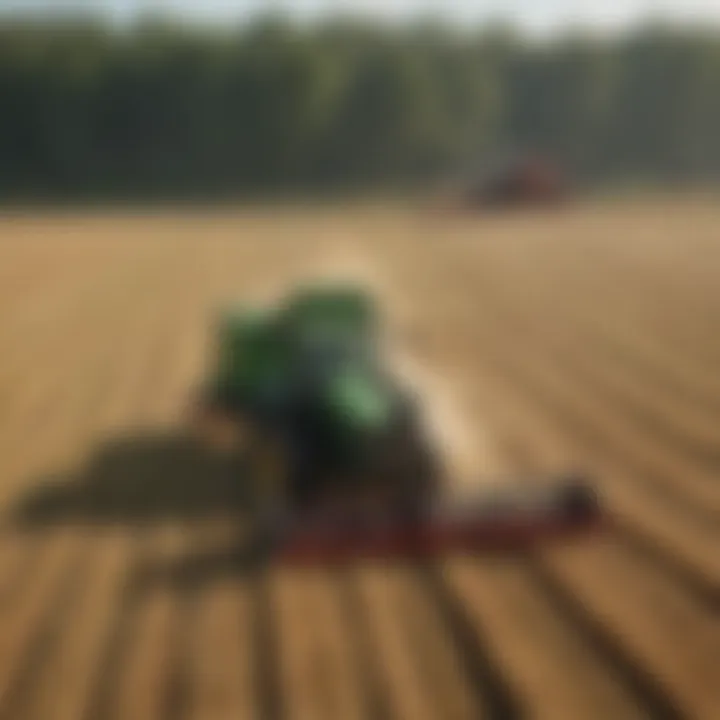Understanding Baling Systems in Modern Agriculture


Intro
Baling systems play a crucial role in modern agriculture, aiding in the efficient collection and storage of crop residues and hay. As agricultural practices evolve, the need for effective baling solutions grows. This article aims to offer a comprehensive overview of the various baling systems available, highlighting their operational mechanics, economic implications, and emerging technologies. Understanding these systems can significantly enhance crop management for farmers and agricultural enthusiasts.
Topic Overview
Definition and Importance
Baling refers to the process of compressing and packaging hay, straw, or other crop materials into manageable units, known as bales. These bales can be in square, rectangular, or round shapes and are easier to handle, transport, and store. The importance of baling systems lies in their ability to reduce spoilage, optimize storage space, and enhance the efficiency of feed use for livestock. Properly managed baling systems can improve overall productivity and profitability in farming operations.
Brief History and Evolution
Historically, farmers relied on manual methods to gather and stack hay. The introduction of mechanical balers in the early 20th century marked a significant change. The first mechanical balers were cumbersome and limited, but advancements over the decades led to more sophisticated machines. Electric and hydraulic systems have improved functionality and ease of use, making baling more efficient. Today, technology continues to advance, with innovations like GPS and automated systems streamlining baling processes further.
Key Techniques and Innovations
Sustainable Farming Practices
With increasing awareness of environmental impacts, sustainable practices have become more integrated into baling systems. Utilizing natural fibers and biodegradable materials in baling twine helps reduce plastic waste. Crop rotation and cover cropping also play a role in sustainable farming, ensuring the soil remains healthy and productive. These practices enhance soil structure and fertility while minimizing the need for chemical inputs.
Advanced Agronomic Technologies
The advent of precision agriculture has affected baling systems as well. Technologies like satellite imaging and drones allow for better monitoring of crop health and yield predictions. This data can lead to optimized baling practices by identifying the ideal times for harvesting and baling crops. Automation in baling machinery reduces labor costs and human error, allowing for a more efficient operation overall.
Practical Applications
Step-by-Step Guides
Implementing an efficient baling system involves several steps:
- Choosing the right baler: Assess the types of crops and expected yield to select an appropriate baler model.
- Proper timing: Monitor crop moisture levels to determine the best time for baling.
- Setting up the equipment: Ensure that the baler is functioning optimally and is well-maintained.
- Baling process: Operate the baler according to manufacturer specifications, ensuring uniform bale density.
- Storage: Store bales in a dry, well-ventilated area to prevent spoilage and deterioration.
Case Studies or Real-World Examples
Several farms have successfully integrated advanced baling systems into their operations:
- Smith Family Farm: In South Dakota, a family-run farm adopted a round baler with GPS technology, leading to a 15% increase in yield per acre. They reduced field losses significantly during the baling process.
- Green Pastures Farm: This operation in California implemented sustainable practices by using biodegradable twine for their square bales, contributing to environmental preservation while maintaining profitability.
"The transition to advanced baling techniques has not only improved our efficiency but also positively impacted our environment."
In summary, understanding and optimizing baling systems is essential for modern agricultural practices. As farming faces new challenges, staying informed about innovations and techniques is vital for success.
Intro to Baling Systems
Baling systems play a crucial role in modern agriculture, shaping how crops and fodder are collected, stored, and transported. The process of baling is not merely about gathering material into compact forms; it enhances the efficiency of operations and facilitates easier handling. Farmers and agricultural practitioners have long relied on these systems to maximize yield and minimize waste in their practices.
Definition and Purpose of Baling
Baling can be defined as a method used for compacting agricultural materials, such as hay, straw, and other crop residues, into manageable bundles. The primary purpose of these bales is to facilitate storage, transportation, and efficient usage. By compressing these materials, farmers can reduce the volume significantly, thus optimizing space during storage.
Moreover, baling serves several additional functions: it protects the crops from weather elements, reduces spoilage, and makes feeding livestock easier. In turn, this enhances the overall productivity and sustainability of agricultural practices. The design of baling systems has evolved over time, reflecting the need for increased efficiency and adaptability in variable agricultural landscapes.
Historical Context
The history of baling systems dates back to the late 19th century when early designs began to emerge alongside advancements in agricultural machinery. Initially, manual methods dominated, requiring substantial labor and time. However, the introduction of steam-powered machines marked the beginning of a transformation in baling technologies.
As agricultural practices evolved, so did technology. The 20th century saw the widespread adoption of both square and round balers, each type offering distinct advantages. Square bales, for instance, are easier to stack and transport due to their shape, while round bales are preferred in many situations for their ability to minimize spoilage in the field.
Today, innovations continue with a focus on automation and efficiency, driven by both economic needs and advancements in material science. This has lead to systems that not only meet the practical demands of baling but also consider ecological impacts, aligning well with contemporary sustainable agriculture practices.
"Understanding the historical progression of baling systems offers valuable insights into modern agricultural practices and potential future developments."
Types of Baling Systems
Understanding the types of baling systems is crucial in modern agriculture. Different systems have unique attributes that suit various crops and operational methods. This section discusses square bales, round bales, and the distinction between small and large bales. Each type has its unique features, implications for crop management, and utilization advantages. Choosing the right type can enhance efficiency, reduce waste, and optimize storage for farmers.
Square Bales
Square bales are rectangular and compact, making them easy to stack and store. They are common in smaller farms and can be handled using standard equipment.
Advantages
One significant advantage of square bales is the efficiency in storage. They can fit snugly in barns or storage facilities, maximizing space utilization. Their uniform shape allows for easier transportation and stacking.


Another notable feature of square bales is the ease of handling. Farmers can use conventional equipment for loading and unloading. This can save time and reduce the physical strain associated with baling.
These factors contribute to their popularity, especially in small-scale operations. Square bales are often preferred for hay and straw, as they allow for organized arrangement, making access more manageable during the winter months.
Disadvantages
A key disadvantage of square bales lies in their weight and size. When wet, they can become heavy and challenging to lift, which may require additional machinery. This leads to higher operational costs in certain situations.
Moreover, the time-consuming baling process can be an issue. Creating square bales may take longer than round bales, especially when handling large fields. This consideration can impact overall productivity during peak harvest times.
Round Bales
Round bales have grown in popularity due to their unique features. Grounded in modern mechanization, they represent a shift towards convenience.
Advantages
The key advantage of round bales is their ease of wrapping and storage. Their cylindrical shape allows for better moisture drainage, which reduces spoilage. Additionally, they can be stored outside without the risk of water accumulation that often affects square bales.
Round bales are also generally lighter than their square counterparts, making them more manageable for larger farms. This leads to faster operations as fewer trips are needed to transport these bales. Farmers find this to be a noteworthy benefit, especially when handling extensive acreage.
Disadvantages
One main disadvantage of round bales is their size. Since they are bulkier, they occupy more space, which can be problematic if storage area is limited. Furthermore, unsupervised outdoor storage can lead to a higher risk of loss due to weather conditions.
Their uneven shape can result in challenges during transportation, requiring specialized handling equipment. This can increase operational complexities for some farmers.
Small vs. Large Bales
The choice between small and large bales often boils down to specific farming needs and capabilities. Small bales are easier to manage and ideal for smaller operations or specialized needs like feeding livestock on-site. Large bales, on the other hand, cater to broader farming operations, facilitating larger harvests and simplified logistics.
Ultimately, understanding the advantages and considerations of each type helps farmers choose the right baling system, tailored to their agricultural practices, operational capacity, and resource management.
Mechanics of Baling Systems
Understanding the mechanics of baling systems is essential in the discussion of agricultural practices. This section delves into specific elements of baling, highlighting benefits and considerations that can impact efficiency and productivity. The focus is on how equipment functions and how processes are executed, as these factors are crucial in optimizing hay and crop management.
Baling Equipment Components
Feeding mechanisms
Feeding mechanisms play a pivotal role in the overall functionality of baling systems. They are designed to transport harvested materials into the baler for processing. A key characteristic of a good feeding mechanism is its efficiency in transferring crop materials without damage or loss. This is a beneficial choice as it maximizes yield and maintains the quality of the baled product.
A unique feature of feeding mechanisms includes adjustable feeding speeds, allowing operators to adapt to varying moisture levels and crop types. This adaptability results in higher efficiency. However, a disadvantage may be complexity in settings, which can be a learning curve for operators not familiar with the equipment.
Compressing mechanisms
Compressing mechanisms are central to the baling process. They compress the crop material into bales, a critical step for ensuring durability and ease of handling. A key characteristic is their ability to adjust compression force, making it possible to create bales of various density. This flexibility in application is important as it allows for customization based on specific crop requirements and storage conditions.
One unique aspect is the integration of hydraulic systems in modern balers, enhancing the compressing process. These systems allow for uniform pressure, resulting in consistent bale quality. However, the high-tech nature of hydraulic systems can result in increased maintenance needs, posing potential challenges for less experienced operators.
Operational Process
The operational process of baling encompasses the steps taken from harvesting crops to preparing them for storage. Understanding these steps is vital for ensuring optimal efficiency and minimizing waste.
Harvesting and preparing crops
Harvesting and preparing crops is the first crucial phase in the baling operation. The key characteristic of this stage is its impact on the quality of the harvested material. Proper techniques promote uniformity and reduce waste, demonstrating why this stage is so valuable within the baling process.
An important feature is the use of proper cutting and conditioning equipment, which can significantly affect moisture content and the overall quality of the crop. However, if not managed carefully, factors such as weather can influence the harvesting process, making it not always predictable.
Baling and wrapping
Baling and wrapping is the final step in the baling operation and is equally important. This process ensures that the bales are secured and protected from environmental conditions. A notable characteristic here is the speed and efficiency of the baling equipment employed. Well-timed wrapping minimizes spoilage and enhances marketability.
Unique features of modern baling systems include the ability to wrap bales in one continuous process, improving productivity by reducing labor needs. However, challenges may arise when dealing with different crop types or sizes of bales, which require careful adjustment of the equipment.
Efficient mechanics and operational processes significantly impact the profitability of agricultural enterprises by optimizing production and minimizing waste.
Understanding these aspects of baling systems sets the foundation for discussing economic implications and best practices in later sections.
Economic Implications of Baling
Understanding the economic implications of baling systems is essential for effective agricultural management. Baling equipment represents a significant investment and requires ongoing financial considerations. The efficiency of a baling system directly impacts both operational costs and labor dynamics in agricultural settings. Evaluating the components of costs gives farmers and practitioners insight into maximizing profits while minimizing waste and labor.
Cost of Equipment


Initial investment
The initial investment in baling equipment often dictates the overall viability of a farming operation. This investment includes not only the purchase price but also financing options available to farmers. For many, the costs can be steep, making it crucial to analyze the potential return on investment.
Key characteristics of initial investments include the durability and efficiency of machinery. High-quality balers, like those manufactured by John Deere or Case IH, may require larger upfront capital but offer long-term savings through reliable performance.
Unique features of such equipment, like automated systems or compatibility with various crop types, provide advantages that justify the initial cost. However, the high price tag can deter smaller operations from investing.
Maintenance costs
Maintenance costs are a central aspect of owning baling equipment. The longevity and performance of balers can significantly affect profitability. Regular maintenance ensures machinery operates at peak efficiency, helping to avoid costly breakdowns.
One important characteristic is the frequency of service required. Some equipment requires more frequent servicing, which can add to overall expenses.
Another unique feature of maintenance is the availability of parts and service. Older models may incur higher costs as parts become scarce. In contrast, newer models might offer warranties that reduce maintenance outlays.
Labor Considerations
Operator expertise
Operator expertise plays a vital role in economic outcomes from baling systems. Skilled operators not only handle machinery efficiently but also enhance safety and productivity. A knowledgeable operator can quickly troubleshoot minor issues, which helps to minimize downtime.
The selection of highly trained operators can lead to significant benefits. Advanced training programs and certifications are now readily available for those looking to improve their skills in operating specialized equipment. This can also lead to better team dynamics and overall morale on the farm.
An important consideration is that the investment in operator training can pay off in increased productivity. However, not all operators come with equal skills, leading to variations in effectiveness.
Labor costs
Labor costs are another fundamental economic factor. They encompass wages, benefits, and associated overhead costs. The selection of equipment often influences how many workers are needed. Mechanized baling systems, such as those made by New Holland, lower labor needs while boosting output.
The prevailing wage rates also affect labor costs in different regions. The total labor cost must be factored into the overall budget to establish profitability. The economic ramifications of this can be profound, especially in competitive markets where margins are thin.
An essential characteristic of labor costs involves the balance between automation and manual labor. Depending on a farm's specific situation, finding the right mix can maximize profits while keeping expenses manageable.
"Investing in both equipment and training cannot be overstated when considering the economic implications of baling systems."
By thoroughly understanding costs and labor dynamics, agricultural practitioners can make informed decisions that enhance their operational efficiency, thus leading to sustainable improvements in productivity.
Technological Advancements in Baling Systems
The rapid evolution of technology has significantly impacted many industries, including agriculture. Within this field, baling systems have benefitted from innovations that enhance efficiency, productivity, and sustainability. Understanding these advancements is crucial for modern farmers and agricultural practitioners seeking to optimize their operations. Key elements of these technologies include automation, smart solutions, and environmental considerations that further influence the effectiveness and acceptability of baling practices.
Automation and Smart Baling Solutions
Automation in baling systems is being adopted to streamline operations and reduce the need for extensive manual labor. Automated balers can function with minimal human intervention. They allow for continuous operation, which is especially valuable during peak harvesting times. Alongside automation, smart technology can monitor the baling process in real-time. By providing data analytics on performance, this technology enables operators to optimize load settings.
For example, some balers are equipped with sensors that monitor moisture levels and adjust the wrapping process accordingly. This can prevent spoilage and maintain hay quality. The integration of GPS technology also allows for efficient field mapping, which further aids in maximizing productivity during baling operations. These innovations result in considerable time savings and decreased labor costs, making automation a worthwhile investment for many farmers.
Environmental Considerations
Sustainable Baling Practices
Sustainable baling practices focus on reducing the environmental footprint of agricultural operations. One specific aspect is the use of biodegradable twine and wraps, which minimize plastic pollution. Such materials break down naturally, contrasting with conventional plastic wraps that contribute to long-lasting waste. The key characteristic of sustainable practices is their ability to maintain crop integrity while also being eco-friendly.
Farmers who adopt these sustainable practices find them appealing due to increasing consumer demand for environmentally responsible methods. However, the effectiveness can vary, and farmers may need to assess the unique features of different sustainable materials. While these practices are beneficial in promoting an eco-friendly image, some may face higher initial costs due to the premium nature of sustainable products relative to traditional options.
Impact on Soil Health
Impact on soil health is another critical consideration in the context of baling systems. Baling methods that leave residual crop matter can contribute positively to soil structure and fertility. For example, allowing some crop residue to remain on fields after baling can improve erosion resistance and support microbial activity within the soil. The key characteristic here is the enhancement of soil quality, which serves long-term agricultural productivity.
This approach has gained popularity in sustainable agriculture, as it aligns with practices aimed at improving land health. However, farmers must balance this with the necessity of harvesting crops for economic needs. The uniqueness of this concept lies in its dual focus—ensuring that immediate agricultural goals are met while protecting soil integrity. Overall, the advantages of these practices include enhanced biodiversity and better nutrient retention, whereas disadvantages could involve initial economic trade-offs or education around new practices.
"Sustainable practices in baling not only protect the environment but also contribute to healthier soil ecosystems. Farmers must consider integrating these practices to ensure long-term agricultural viability."
Best Practices for Effective Baling
Effective baling is crucial in agriculture as it aids in crop preservation, enhances ease of handling, and reduces potential losses. Best practices encompass timing, conditions, and spoilage prevention strategies. Understanding these aspects leads to improved efficiency and preservation of valuable agricultural products.
Timing and Conditions
Baling at the right time and under suitable conditions can significantly influence the quality of hay or crop. Optimal timing ensures that the crops are neither too wet, which can lead to mold and spoilage, nor too dry, which may diminish nutritional value and lead to excessive dust.
Factors to consider include:
- Weather: Clear weather with low humidity is ideal. This prevents excessive moisture during baling.
- Crop maturity: Knowing the plant’s developmental stage helps in deciding when to cut. Accurate timing will increase nutrient concentration in the bales.
- Soil conditions: Dry or slightly moist soil will lead to healthier crops. Proper soil conditions can also affect the timing of harvesting and how soon the crops can be baled.


Preventing Spoilage
Preventing spoilage is a major concern in baling systems. Spoilage can drastically reduce the quality of the hay or harvested crops, leading to economic losses for farmers. Careful storage methods and effective moisture control are vital in minimising this risk.
Storage methods
Proper storage methods contribute significantly to the longevity of bales. Bales should be stored in a dry location that protects them from elements like rain or snow. An ideal storage environment helps ensure that bales maintain their nutritional value and quality.
Key characteristics of effective storage methods include:
- Elevation: Storing bales off the ground prevents contact with damp soil.
- Protection from weather: Covering bales or using buildings for storing can shield bales from moisture.
These methods are beneficial as they minimize spoilage and maintain bale quality for longer periods. Unprotected bales, on the other hand, can absorb moisture and lose value.
Moisture control
Moisture control in bales is essential for preventing spoilage. High moisture content can lead to mold growth, which ultimately affects the health of livestock consuming the hay, as well as degrade the crop's quality. Monitoring the moisture levels before and after baling is imperative.
Key aspects of moisture control include:
- Moisture measurement tools: Using moisture meters to assess the condition of crops before baling ensures optimal quality.
- Drying methods: If moisture content is too high, using drying methods to decrease it can preserve the crop better.
Moisture control is a popular focus in modern baling systems because consistent quality is crucial for a successful harvest. Balers equipped with moisture sensors can provide real-time data, guiding decisions that impact the overall quality of the bales.
By following best practices for effective baling, farmers can reduce spoilage and maintain the nutritional value of their harvests.
Implementing these best practices in baling can drastically enhance the quality and longevity of agricultural products.
Case Studies in Baling Systems
Case studies serve as important frameworks in understanding the practical application of baling systems within the agricultural sector. Through the examination of real-life examples, agricultural practitioners can glean insights into both the successes and challenges faced in implementing different types of baling technologies. By identifying trends and outcomes from specific cases, farmers can make more informed decisions regarding their own operations. Case studies also highlight the diversity of practices across various agricultural settings, showing how environmental conditions, available resources, and management styles influence the effectiveness of baling solutions.
Successful Implementations
One noteworthy case study involves a large-scale hay producer in the Midwest United States who transitioned from small square bales to round bales. This shift was prompted by the need for better efficiency in both time and labor. The round baling system allowed the producer to not only reduce labor costs—since fewer handling steps were required—but also to increase the volume of bales produced per hour. Data collected from this transition showed a significant increase in profitability due to reduced operational costs. Partial automation in wrapping also played a crucial role, making the process smoother and requiring less manpower during peak seasons.
Another successful implementation can be found in a dairy operation in New York State. The farm adopted a custom-designed baling system which integrated smart technology. This system utilized sensors to monitor moisture levels in the hay. As a result, the quality of feed improved significantly, leading to better milk production rates. The investment in technology provided a solid return as it allowed the farmer to balance costs while ensuring high-quality output for his dairy herd.
In summary, effective case studies emphasize that understanding the local context, leveraging technological innovations, and anticipating the labor requirements are key factors for successful baling system implementations.
Lessons Learned from Failures
While successes stand out in case studies, lessons from failures are equally vital for growth and knowledge accumulation in the field of agricultural baling systems. One case in point involved a farm in Southern California that invested heavily in an advanced bundling technology without adequately assessing its fit for local conditions. The system, while innovative, could not handle the high moisture content typical for the region's forage crops. As a result, poorly managed bales led to spoilage and wastage, causing financial losses. This case underscores the necessity of aligning technology with environmental conditions and crop types to avoid costly mistakes.
Similarly, a grain farm in the Midwest faced significant issues after moving to larger bale sizes thinking it would enhance efficiency. However, they underestimated the transport logistics that larger bales required. The increased weight of the bales complicated transportation, leading to maintenance issues with their hauling equipment and additional labor costs. This failure highlighted the issue of overestimating operational capacity without adequate planning.
"Proper assessment of both the technology and operational capacity can mean the difference between success and failure in agricultural practices."
Future Trends in Baling Systems
The landscape of agriculture is evolving rapidly, with baling systems at the forefront of these changes. Understanding future trends is vital for farmers and agricultural practitioners. Insights into these trends allow for more informed decisions about equipment choices, operational methods, and sustainability practices. As the demand for more efficient and environmentally-friendly practices grows, innovations in baling will become increasingly relevant.
Innovations in Material Science
Advancements in material science are set to transform baling systems significantly. One of the key areas of focus is the development of stronger and lighter materials for baling twine and wraps. These materials must maintain their durability while reducing the overall weight, leading to lower fuel consumption during transport and handling.
Another important innovation is in the composition of bales themselves. Researchers are exploring bio-based materials that could enhance the insulation properties of bales. This could result in improved storage conditions and reduced spoilage rates, which is particularly crucial in a context of food security.
Furthermore, the introduction of biodegradable wrapping films promotes sustainability by minimizing plastic waste. These innovations address urgent environmental concerns while supporting operational efficiency, making them essential for future baling practices.
Market Predictions
The market landscape for baling systems is poised for transformation due to various factors. Increased global demand for hay and forage crops, driven by livestock requirements, is expected to sustain growth in this sector. As a consequence, investment in high-efficiency baling systems will likely become a priority for many farmers.
Economic trends show a shift towards smart technology integration into traditional practices. This includes automated systems that enhance the precision and efficiency of the baling process. Smart balers capable of monitoring and adjusting to varying crop conditions may become an industry standard.
Consumer preferences are also changing, with an increasing ethos around sustainability. Buyers are more likely to support farms that employ eco-friendly practices. Therefore, market competition will intensify around the adoption of sustainable baling technologies, influencing purchasing behavior.
The End
Summary of Key Insights
The key insights presented throughout this article include:
- Types of Baling: Recognizing the differences between square and round bales aids farmers in selecting the most suitable option based on their specific needs and resources.
- Operational Mechanics: An understanding of the components such as feeding and compressing mechanisms ensures optimal use of equipment.
- Economic Considerations: Keeping an eye on the investment costs and labor requirements enables sound financial planning in agricultural enterprises.
- Technological Advancements: Awareness of automation and smart baling technologies can lead to more efficient practices and better environmental outcomes.
These insights reflect the complexity of baling systems and highlight their significance in modern agriculture.
Final Thoughts
Ultimately, the future of agriculture will depend in part on how well farmers adapt their baling strategies to changing circumstances—be it through technological advancements or shifts in market demand. As practices evolve, continuous learning about new innovations and best practices in baling will remain essential. This well-rounded understanding of baling systems not only improves immediate operational efficiency but also contributes to long-term sustainability and growth in agricultural productivity. Drawing connections among the various elements discussed can empower farmers and enthusiasts alike to optimize their operations effectively.



